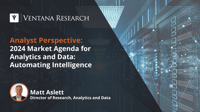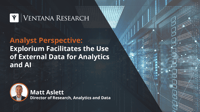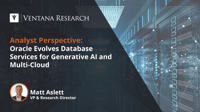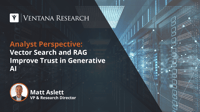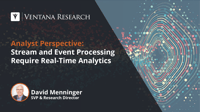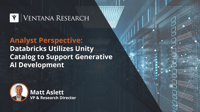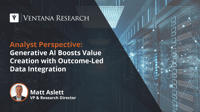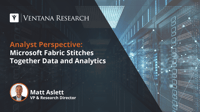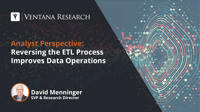Ventana Research recently announced its 2024 Market Agenda for Analytics and Data, continuing the guidance we have offered for two decades to help enterprises derive optimal value and improve business outcomes.
Read More
Topics:
embedded analytics,
Business Intelligence,
Data Governance,
Data Management,
natural language processing,
data operations,
Process Mining,
Streaming Analytics,
Analytics & Data,
Streaming Data & Events,
operational data platforms,
Analytic Data Platforms,
AI and Machine Learning
The phrase ‘big data’ may have largely gone out of fashion, but the concept of storing and processing all relevant data continues to be important for enterprises seeking to be more data-driven. Doing so requires analytic data platforms capable of storing and processing data in multiple formats and data models. This will be an important focus for the forthcoming Data Platforms Buyer’s Guide 2024.
Read More
Topics:
Analytics,
Business Intelligence,
Data Management,
Data,
Digital Technology,
data operations,
Analytics & Data,
AI and Machine Learning
I previously described how Oracle had positioned its database portfolio to address any and all data platform requirements. The caveat to that statement at the time was that any organization wanting to take advantage of the company’s flagship Oracle Autonomous Database could only do so using Oracle Cloud Infrastructure (OCI) cloud computing service, their own datacenter or a hybrid cloud environment. The widespread popularity of Oracle Database and the advanced automation capabilities delivered...
Read More
Topics:
Analytics,
Business Intelligence,
Cloud Computing,
Data Management,
Data,
Digital Technology,
Analytics & Data,
operational data platforms,
Analytic Data Platforms,
AI and Machine Learning
I previously discussed the trust and accuracy limitations of large language models, suggesting that data and analytics vendors provide guidance about potentially inaccurate results and the risks of creating a misplaced level of trust. In the months that have followed, we are seeing some clarity from these vendors about the approaches organizations can take to increase trust and accuracy when developing applications that incorporate generative AI, including fine-tuning and prompt engineering. It...
Read More
Topics:
Analytics,
Business Intelligence,
Data,
Digital Technology,
natural language processing,
Analytics & Data,
operational data platforms,
Analytic Data Platforms,
AI and Machine Learning
In my past perspectives, I’ve written about the evolution from data at rest to data in motion and the fact that you can’t rely on dashboards for real-time analytics. Organizations are becoming more and more event-driven and operating based on streaming data. As well, analytics are becoming more and more intertwined with operations. More than one-fifth of organizations (22%) describe their analytics workloads as real time in our Data and Analytics Benchmark Research and nearly half (47%) of...
Read More
Topics:
Analytics,
Business Intelligence,
Data,
Digital Technology,
Streaming Analytics,
Analytics & Data,
Streaming Data & Events
I previously described how Databricks had positioned its Lakehouse Platform as the basis for data engineering, data science and data warehousing. The lakehouse design pattern provides a flexible environment for storing and processing data from multiple enterprise applications and workloads for multiple use cases. I assert that by 2025, 8 in 10 current data lake adopters will invest in data lakehouse architecture to improve the business value generated from the accumulated data.
Read More
Topics:
Analytics,
Business Intelligence,
Data Governance,
Data Management,
Data,
Digital Technology,
Analytics & Data,
Analytic Data Platforms,
AI and Machine Learning
Despite a focus on being data-driven, many organizations find that data and analytics projects fail to deliver on expectations. These initiatives can underwhelm for many reasons, because success requires a delicate balance of people, processes, information and technology. Small deviations from perfection in any of those factors can send projects off the rails.
Read More
Topics:
Analytics,
Business Intelligence,
Data Management,
Data,
Digital Technology,
data operations,
AI and Machine Learning
Organizations are continuously combining data from diverse and siloed sources for analytical, artificial intelligence and machine learning projects. As the volume of data grows, it becomes challenging for organizations to manage and keep current to extract valuable insights in a timely manner.
Read More
Topics:
Analytics,
Business Intelligence,
AI and Machine Learning,
Data Analytics
I have written before about the rising popularity of the data fabric approach for managing and governing data spread across distributed environments comprised of multiple data centers, systems and applications. I assert that by 2025, more than 6 in 10 organizations will adopt data fabric technologies to facilitate the management and processing of data across multiple data platforms and cloud environments. The data fabric approach is also proving attractive to vendors, including Microsoft, as a...
Read More
Topics:
Analytics,
Business Intelligence,
Cloud Computing,
Data Governance,
Data Management,
Data,
Digital Technology,
Analytics & Data,
Analytic Data Platforms,
AI and Machine Learning
At one point, analytics and business intelligence were considered non-mission critical activities. One of the primary concerns in designing analytics systems was to ensure they didn’t interfere with or draw computing resources away from operational systems. But today, analytical systems are integral to many aspects of operations. More than 9 in 10 participants in our Analytics and Data Benchmark Research reported analytics had improved activities and processes. However, most analytics and BI...
Read More
Topics:
Analytics,
Business Intelligence,
Data Management,
Data,
Digital Technology,
data operations,
Analytics & Data
